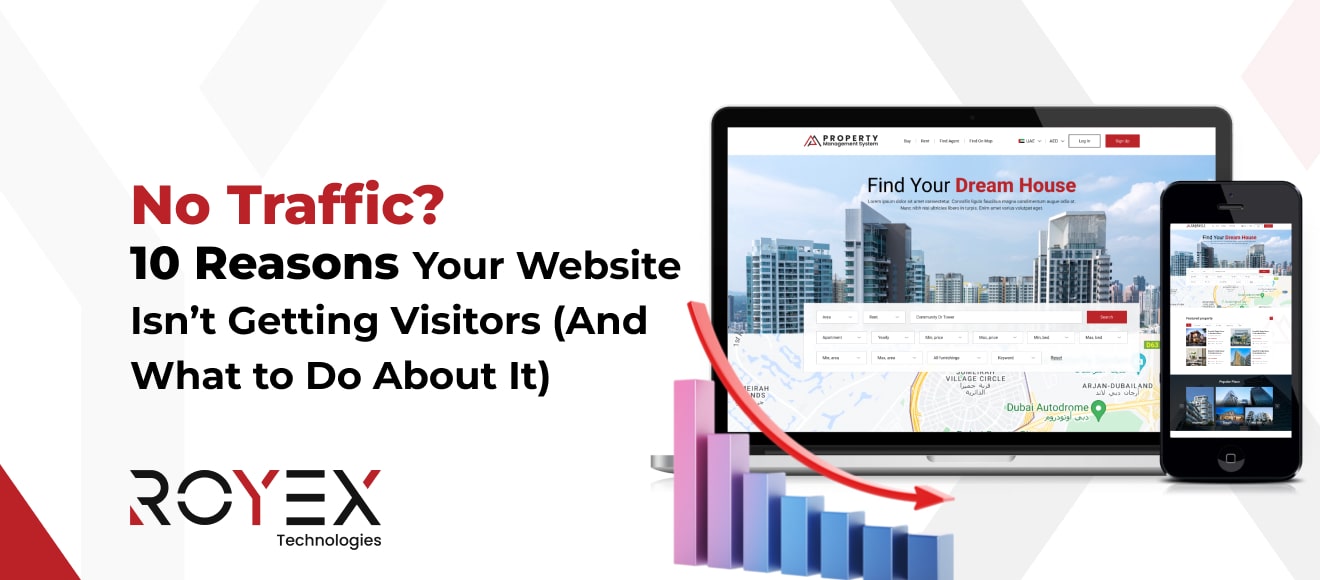
No Traffic? 10 Reasons Your Website Isn’t Getting Visitors (And What to Do About It)
Why Your Website Traffic Is Stuck—and How to Break the Ice
If your website feels like a ghost town—no visitors, no leads, no buzz—it’s time to diagnose the causes. Website traffic reflects how well your site attracts, retains, and engages. Traffic woes lay in gaps across SEO, GEO (Generative Engine Optimization), UX design, content quality, and user trust.
Below are the 10 most common reasons traffic fails to arrive—and exactly what you can do to reverse it.
1. Poor SEO Foundations: You’re Not Visible on Search Engines
If your pages aren’t ranking for valuable keywords, no traffic will show up organically.
What to fix:
-
Optimize page titles, meta descriptions, headers using keyword research.
-
Improve site speed, mobile-friendliness, and HTTPS status.
-
Build a healthy backlink profile through guest posts and partnerships.
-
Fix errors (404s, broken links, duplicate meta tags).
Why it matters:
Around 75% of searchers never click past the first page of results.
To fix this, consider working with a reputable SEO agency in Dubai that handles on-page, technical, and off-page SEO.
2. No GEO Strategy: Invisible to AI-Powered Discovery
The future of online discovery lies with AI assistants—not just Google.
What to do:
-
Publish structured content using schema markup (LocalBusiness, FAQs, HowTo).
-
Ensure clear, semantically-rich copy.
-
Tag each location or service area correctly with geo-coordinates and local context.
-
Create conversational FAQs and summary content that AI models can parse.
This is Generative Engine Optimization—GEO—and it ensures your content is suggested by ChatGPT, Bard, and other AI search tools. Many businesses still neglect this—missing a massive opportunity.
3. Weak Content Strategy: No Value, No Visitors
Your site needs more than sales pitches—it needs to teach, guide, and engage.
Fix it by:
-
Creating long-form how-to guides, in-depth blogs, case studies.
-
Answering customer questions in FAQ-style posts.
-
Using rich media (infographics, video, downloadable PDF).
Why it matters:
70% of traffic comes from blogs and resource pages—not product pages.
4. UX Issues: Visitors Bounce Because Experience is Poor
Even if they arrive, users don’t stick around if buttons are hidden or navigation is unclear.
Fixes:
-
Ensure clarity: sticky headers, visible CTAs, simplified menus.
-
Mobile-first design: buttons sized right, touch-friendly space.
-
Page layout: logical information hierarchy and visual cues.
Make UX intuitive—with minimal friction—and users stay longer, decreasing bounce rates.
5. Slow Loading Times: Nobody Waits Longer Than 3 Seconds
Speed is traffic’s first gatekeeper.
Improve performance:
-
Compress images, use modern formats (WebP).
-
Minify JS/CSS and implement lazy loading.
-
Use CDN and cache reusable content.
-
Optimize server response, hosting, and TTFB.
Why speed matters:
One-second delay in mobile load time can reduce conversions by 20%.
6. Poor Internal Linking: You’re Not Guiding Visitors Deeper
Without good internal links, users don’t discover other pages—spending less time on site.
Best practices:
-
Link contextually to related content (blogs, services).
-
Use relevant anchor text.
-
Create sitemaps and breadcrumb trails.
7. No Promotion Strategy: You Built It—but Didn’t Invite Anyone
After launch, promotion is essential. Even the best site goes unnoticed without outreach.
Promotion channels:
-
Social media (Instagram, LinkedIn, Facebook, YouTube).
-
Local directory listings and Google Business Profile.
-
Influencer partnership or guest features.
-
Email newsletters and remarketing ads.
8. No Analytics: You Don’t Know What’s Working
If you can’t measure, you can’t optimize.
Tools to implement:
-
Google Analytics 4: sessions, bounce, events.
-
Google Search Console: index status, coverage issues.
-
Hotjar or Microsoft Clarity: heatmaps and session recordings.
-
Tag Manager: event tracking without code changes.
Measure interactions like CTA clicks, scroll depth, form completion, and entry/exit pages.
9. Low Credibility Signals: Visitors Don’t Trust Your Brand
New visitors need reasons to engage—trust matters.
Trust-building elements:
-
Display client logos, testimonials, case studies.
-
Use review widgets and certification badges.
-
Share team bios, press features, or awards.
A higher trust score increases engagement and repeat visits.
10. No Content Refresh or Updates: Site Appears Abandoned
Stagnant content gets penalized by both SEO and GEO.
Keep content fresh:
-
Regularly update blog posts and case studies.
-
Refresh product descriptions, add new visuals.
-
Archive outdated pages with 301 redirects.
GEO also rewards sites with up-to-date and accurate structured data.
✅ What You Should Do (Action Plan)
|
Action |
Tool / Method |
|
Keyword research |
SEMrush / Ahrefs / Moz |
|
On-page SEO audit |
Screaming Frog / Sitebulb |
|
Schema markup |
JSON-LD schema generators |
|
Analytics setup |
GA4 + Tag Manager |
|
Session tracking |
Hotjar / Microsoft Clarity |
|
Content calendar |
Google Sheets or Airtable |
|
Promotional planning |
Hootsuite / Buffer |
|
Page speed audit |
Google Lighthouse / GTmetrix |
🧩 How Royex Builds Sites That Attract Traffic from Day One
At every stage, Royex Technologies weaves traffic readiness into your website development process.
🔹 Strategy & SEO from the Start
We begin with competitive keyword research and structured content planning, laying the foundation for SEO growth.
🔹 GEO-Enabled Design
Our expert team integrates GEO techniques—schema markup, conversational content, AI-aware copy—so your site is visible to both search engines and generative AI engines. Visit our service: GEO Service Provider – Royex Technologies
🔹 Conversion-First UX
Using UX design principles aligned with SEO readability and internal linking, we ensure users navigate seamlessly—boosting session duration and lowering bounce.
🔹 Performance & Mobile Optimization
We deliver mobile-first, high-speed web builds with optimized images, preloading patterns, and CDN support.
🔹 Trust Elements & Credibility
From testimonial carousels to secure checkout flows, we help you earn credibility instantly through design.
🔹 Content Strategy Support
Our team also helps plan blog/editorial calendars that attract traffic via educational content and reinforce SEO & GEO goals.
🔹 Analytics & Heatmap Integration
We preconfigure GA4, Tag Manager, and behavioral tools so you can track engagement clearly and iterate from day one.
Visit our web design offering: Web Design Company Dubai – Royex Technologies
🚀 Final Thoughts: Traffic Isn’t Magic—It’s Built
Traffic doesn’t arrive by accident. It’s the result of strategic planning—combining strong SEO, future-ready GEO, engaging UX design, fresh content, technical excellence, and continuous promotion.
If your website lacks traffic, audit the areas above—and consider working with experts who understand every step of the journey.
Royex Technologies builds traffic-ready websites from kickoff. With integrated SEO, GEO, and UX design, your site won’t just look good—it will perform. Ready to attract visitors who convert? Let us help you build a website designed for connection and conversion.





